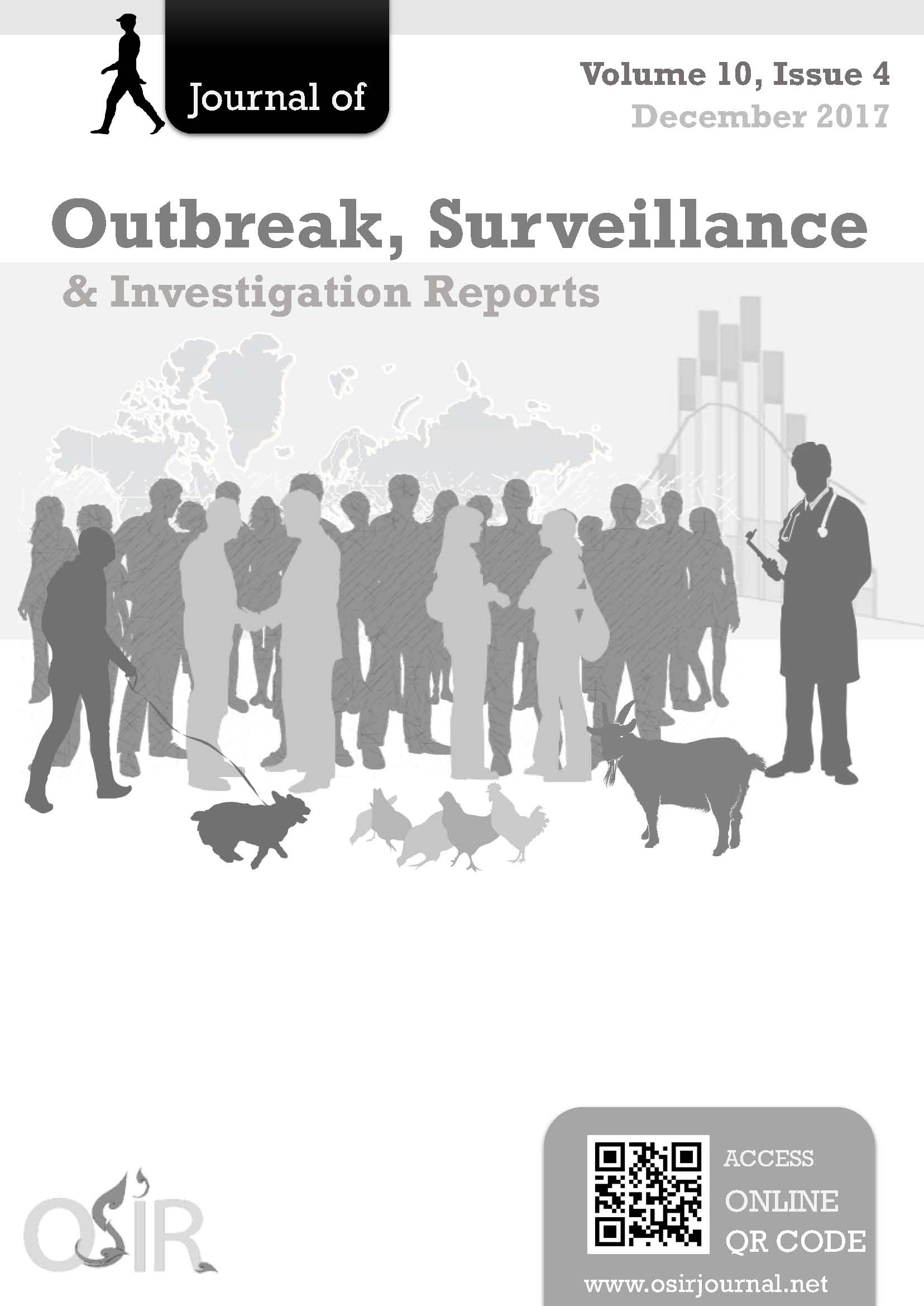Plant Poisoning Outbreak in a Primary School in the northern Thailand, October 2015
DOI:
https://doi.org/10.59096/osir.v10i4.263076Keywords:
plant, poisoning, Jatropha, coral plant, outbreak, ThailandAbstract
On 6 Oct 2015, the Thailand Bureau of Epidemiology was notified of a food poisoning outbreak among students in a primary school. An investigation was performed to verify the diagnosis and outbreak, describe epidemiological characteristics, identify the source, and provide proper recommendations in order to prevent further outbreaks. Descriptive and retrospective cohort studies were conducted. Medical records at the hospital were reviewed, and teachers, students, cooks and janitors from the school were interviewed. A suspected case was a person in the school with at least two of the followings: nausea, vomiting, abdominal pain or diarrhea during 5-9 Oct 2015. The water samples were sent to the National Institute of Health for bacterial culture. The suspected plant was examined at the Plant Varieties Protection Division for species identification. Bivariate analysis was used to determine the food items associated with illness. The attack rate was 28.8% with 19 suspected cases out of total 66. Most common symptoms included nausea (85.0%), vomiting (85.0%) and abdominal pain (60.0%). All of the suspected cases consumed the coral plant (Jatropha multifida), which was also the only significant risk for the illness (P value <0.001). Therefore, this event was a coral plant poisoning outbreak. To prevent future outbreaks, a fence around the herb garden with a warning sign should be set up in the school, along with adequate warning of herb toxicity.
References
Begg J, Gaskin T. Jatropha multifida. 1994 [cited 2017 Sep 16]. <http://www.inchem.org/documents/pims/plant/jmulti.htm>
Natural Resources Conservation Service, United States Department of Agriculture. Jatropha multifida L. coralbush [cited 2017 Sep 16]. <https://plants.usda.gov/core/profile?symbol=JAMU>
Right Diagnosis. Jatropha multifida poisoning. 2015 Aug 13 [cited 2017 Jun 13]. <http://www.rightdiagnosis.com/j/jatropha_multifida_poisoning/intro.htm>.
Sriapha C, Tongpoo A, Wongvisavakorn S, Rittilert P, Trakulsrichai S, Srisuma S, et al. Plant poisoning in Thailand: a 10-year analysis from Ramathibodi Poison Center. Southeast Asian J Trop Med Public Health. 2015 Nov;46(6):1063-76.
Swaddiwudhipong W, Kunasol P, Sangwanloy O, Srisomporn D. Foodborne disease outbreaks of chemical etiology in Thailand, 1981-1987. Southeast Asian J Trop Med Public Health. 1989 Mar;20(1):125-32.
Centers for Disease Control and Prevention. Epi Info. [cited 2017 Jun 13]. <http://wwwn.cdc.gov/epiinfo/html/prevVersion.htm>
World Health Organization. Guidelines for drinking-water quality. 4th ed. Malta: World Health Organization; 2011.
Richards MS, Rittman M, Gilbert TT, Opal SM, DeBuono BA, Neill RJ, et al. Investigation of a staphylococcal food poisoning outbreak in a centralized school lunch program. Public Health Rep. 1993 Nov-Dec;108(6):765-71.
Santayakorn S, Sitthi W, Wongphruksasoog V, Ardkham B, Sujit K, Kanjanasombat H, et al. Bacillus cereus food poisoning outbreak in a kindergarten school, Bangkok, Thailand, December 2009. 2012;5(2):9-15.
Guruge K, Seneviratne RD, Badureliya C. A case of Jatropha multifida poisoning. Sri Lanka Journal of Child Health. 2007;36:148 [cited 2017 Jun 13]. <http://citeseerx.ist.psu.edu/viewdoc/download?doi=10.1.1.429.735&rep=rep1&type=pdf>
Levin Y, Sherer Y, Bibi H, Schlesinger M, Hay E. Rare Jatropha multifida intoxication in two children. J Emerg Med. 2000 Aug;19(2):173-5.
Chomchai C, Kriengsunthornkij W, Sirisamut T, Nimsomboon T, Rungrueng W, Silpasupagornwong U. Toxicity from ingestion of Jatropha curcas ('saboo dum') seeds in Thai children. Southeast Asian J Trop Med Public Health. 2011 Jul;42(4):946-50.
Kumar KJ, G MV, Devapura B, Sujithkumar T. Accidental Jatropha curcas poisoning in children. Natl Med J India. 2013 Nov-Dec;26(6):359.
Shah V, Sanmukhani J. Five cases of Jatropha curcas poisoning. J Assoc Physicians India. 2010 Apr;58:245-6.
Langrand J, Médernach C, Schmitt C, Blanc-Brisset I, Villa AF, de Haro L, et al. Poisoning with Jatropha curcas: 24 cases reported to Paris and Marseille Poisons Centers. Bull Soc Pathol Exot. 2015 Mar;108(2):139-43. Epub 2015 Jan 20. French.
Downloads
Published
How to Cite
Issue
Section
License
Copyright (c) 2023 Outbreak, Surveillance, Investigation & Response (OSIR) Journal

This work is licensed under a Creative Commons Attribution-NonCommercial-NoDerivatives 4.0 International License.









